 |
|
The Tang- Lang language
author Attila Foldes
|
| The tangent - we know - expresses the ratio of two distances. That is, how much longer one distance is in comparison to the other. At the same time, of course, the two straight lines enclose some kind of angle. Just as we could see in the picture showing the Earth-Sun distance, as an astronomical unit, which is equivalent to 1 and is indicated by an object (formation) positioned at an angle of 45 degrees so it. In this same place the number 1.524 representing the Mars-Sun distance is indicated by a volcano positioned at 56.726 degrees to it. |
Before
we deal with the tang-Lang of cosmos let we recognise the earth's tangent
ABC.
The
ancient phoenicians used this letters. Only the first 6 letter existed
in the most ancien times.
So,
A, B, G, D, E, Z.
greek
Phoenician ancient
newer classic
 |
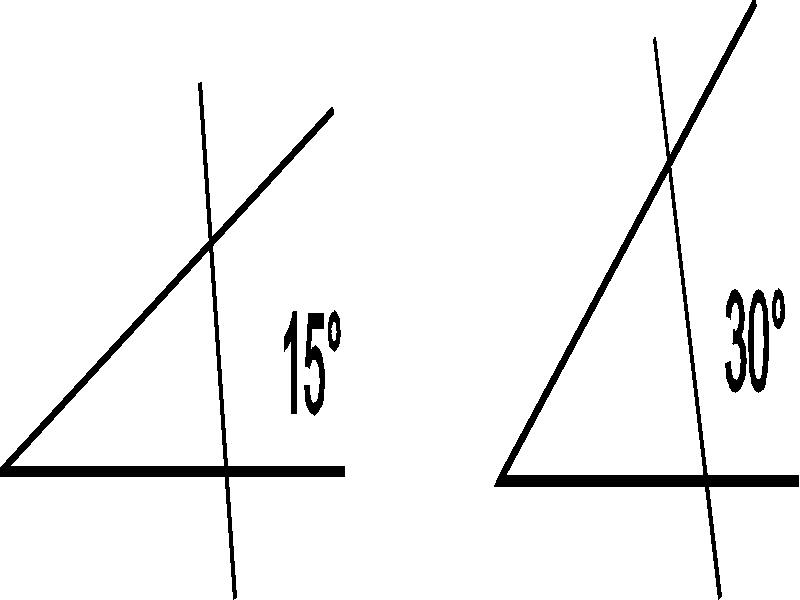
Even like this we could be mistaken, if we were to be just a little careless in how we drew the sign. What is to be done ? The two angles could be distinguished by depicting the angle with a curved marking, denoting that the angle were bigger. If the curve were well-defined it certainly would not be misinterpreted.
A
B


15°
15+15=30°
When
the Phoenicians began to work out humanity's first letters they “stole”
our idea, so to speak, since in the last phase of the procedure explained
above it was the Phoenicians letters “A” and “B” that we designed.
Now
let us continue following the system of letters that proceeds in
steps of 15 degrees.
The
next step is to 45 degrees.
G
 45° This is the most ancient phoenician G.
45° This is the most ancient phoenician G.
30+15=45
The
Phoenician “G”, today's Greek and Cyrillic “G”.
What
is the next one ?
Letter
“D”, which according to its place in the order corresponds to an angle
of 60 degrees, since
45
+15 = 60
 60° The Phoenician “D”
is delta in today's Greek alphabet.
60° The Phoenician “D”
is delta in today's Greek alphabet.
D
=45+15=60
But
let us hurry on. The next one is 60 +15=75 degrees. At this stage we run
out of ideas, for not one mathematics textbook enlarges upon how to obtain
the mathematical value of this angle. It is complicated! Let us consider
that we already have 45 degrees and 15 degrees. If we draw the 45 degrees,
we can add to 15 degrees “beards” : 45+15+15= 75.
 E This
became our letter “E” of today.
E This
became our letter “E” of today.
45+15+15=75°
The
90 degree angle presents no problem, because this has to show the end of
the procedure. That is, the 90 degrees.
. 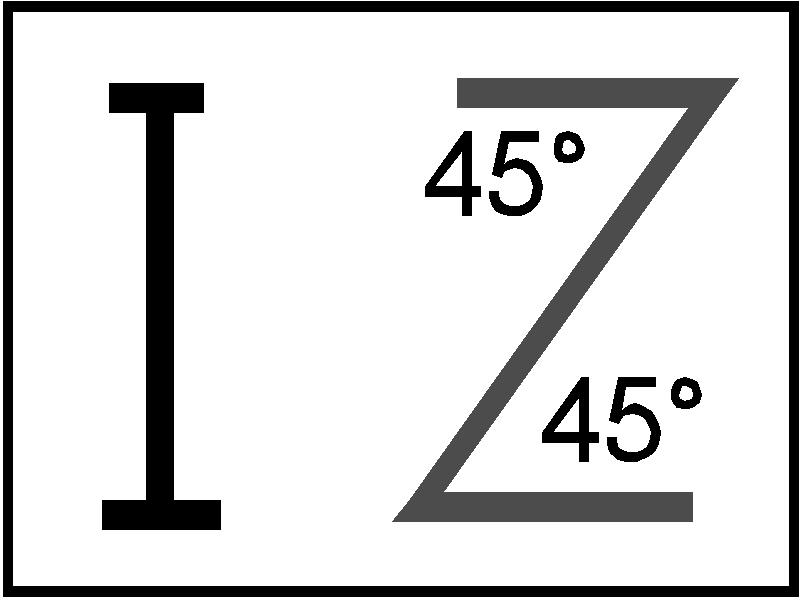 This letter
“Z” today, and always has been.
This letter
“Z” today, and always has been.
45+45=90°
We must go no further, for we have reached the ancient letter denoting
the end, “Z”. Thus from our ancestors we inherited 5 valid letters
and a symbol representing the ultimate letter.
The
first 5 letters are the PENTATONIC symbols.
Now,
let we see some explains from the volcan-system message.
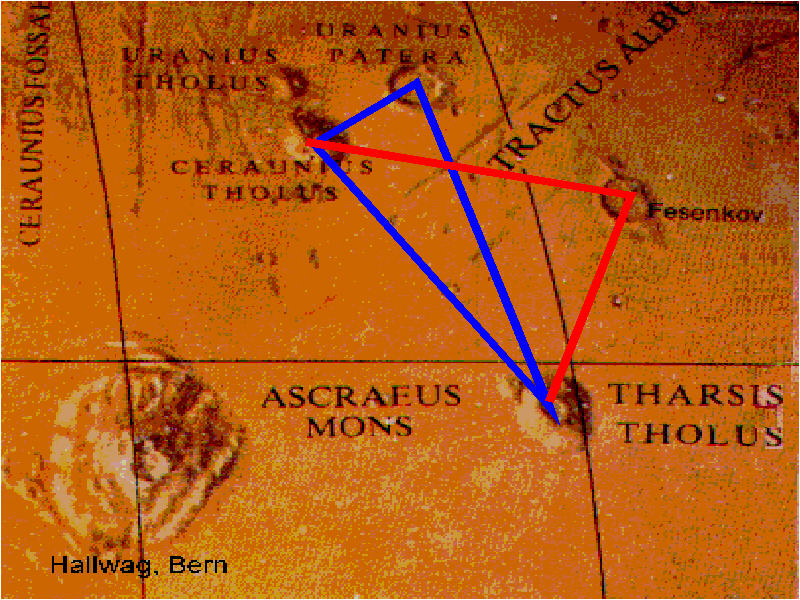 |
Fig.
2.
Between
the eyes is a basic line for two triangles.
(Map, Hallwag, Bern) |
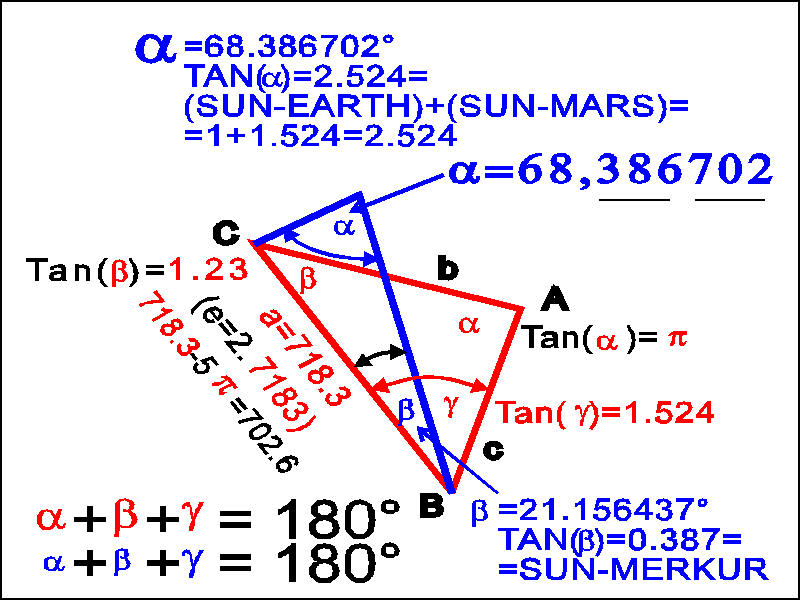 |
Fig. 3 |
The
use of “Tangent construction”.
| Let we verify them. |
Datas of the blue triangle:
alfa
= 68.386702°
(Tg(alfa) = 2.524 = Sun-Earth (1) + Sun-Mars(1.524))
beta
= 21.156437°
(Tg(beta) = 0.387 = Sun-Mercury
gama
= 90.456861°
Look
at the crater above the upper eye, slightly to the right. (See fig. 3).
This appears to be the result of some meteorite crashing down, because
an enormous flat area surrounded by a great ditch has been produced.
(Directed meteorit?). And still, it is a volcanic area, for tests show
it to be a hotspot. From the centre of this hotspot the rim of the volcanic
crater is traced out like an arc.
It
is not a mound, a dome that is in question here, but a level area surrounded
by a ditch. If we were to use our hands to mark out a direction radiating
from the centre, then the rim of the crater would trace out the arc
in exactly the same way as at school we used a compass to mark off points
between two lines.
The
astronomical data given so far is repeated in yet another way.
Now,
possessed of the knowledge of the tangent, let us return to our level crater.
Notice
the small triangle marked in blue, seen above the eyes. The tangent value
of our angles give the same number as was seen on the diagram shown
earlier. That is, 2.524. This is the sum of the values Sun-Earth=1
and Sun-Mars=1.524. (1+1.524=2.524).(See fig. 2, fig. 3)
Only,
here it is not a straight line that has been divided into such a ratio,
but it is the sides of a triangle that are the different distances. Which
is why an angle also appears in the ratios of the sides. This angle
represents the value of 2.524 as the tangent of the angle.
A
justifiable question can be raised, namely what angle (alfa)
has the tangent of 2.524 ? The answer is 68.386... degrees, because tan(68.386702)=2.524.
This is the Tangent-Language. It is known by anybody but not used. The
other angle of the triangle also carries important information. It shows
the Sun-Mercury mean distance. (0.387), because tan(21.156437)=0.387.
But
here, likewise, attention must be given to the decimals, for they could
be important.
Just
as the angle of the 1773.6 km angle sides repeated the 1773.6 in angle
50.61773 degrees, putting the decimal 6 to the front, so in the decimals
here 0.387 and 702.6 are joined up and appear as 68.386702 degrees, which
is now the fifth expression of the astronomical base unit. (Later the middle
distance of Mercury can be seen).
Now
we can understand why the mean distances of Earth and Mars had to be dealt
with as the sum of two values. (1+1.524=2.524).
This
is the only way in which, with one angle, we can express:
-
the Sun-Earth astronomical unit ........................................(1.00
AU),
-
the Sun-Mars astronomical distance ................................(1.524
AU),
-
the Sun-Mercury astronomical distance ............................(0.387
AU),
-
the reduced value’s digits of the astronomical distance
(0.007026).
This
seems unbelievable. It seems that the geometrical order of these formations
wishes to teach us something, just as Frendenthal tried with his alphabet
to teach the extraterrestrial intelligences.
Naturally,
the truth of the angles might be doubted, since exact measurements could
not be made, due to the distortion caused by the “spherical view” given.
In Fact, this system could only be proven as true if it were to turn up
in places where the truth contained in it could be defined with greater
accurancy.
Which
is why the single triangle found previously is not proof enough. What would
be really satisfactory is if, where called for, this data were to appear
again, but this time in the form of the above “tangent-language”.
Let
us see if this is so.
To
the north of the lower Mars-crater of the large triangle there are
two small volcanic craters.
Since,
likewise, we are on the equator we can carry out our measurements with
no great complications, because the angles and the distances will be relatively
accurate. The only inaccurancy will be found in the difference there is
between the lines of latitude and longitude.
The
small volcano, once again, is of a peculiar form, but let us not bother
with that for the time being.
Of
the two little volcanoes, one is nearer to the Earth volcano, the other
to Mars. Let us look at the angles first. We will examine the one near
to the Earth volcano. Its angle of inclination is exactly 45 degrees. The
tangent of this is 1, that is, it represents the Sun-Earth distance (1).
This is no suprise, it is exactly where it ought to be.
The
other - the one close to Mars - is at 56.73 degrees. It is not possible
to measure this with such accuracy, but now we know exactly the value
it should be.
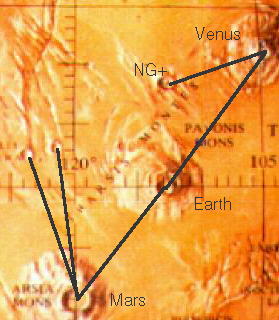
Fig. 4 |
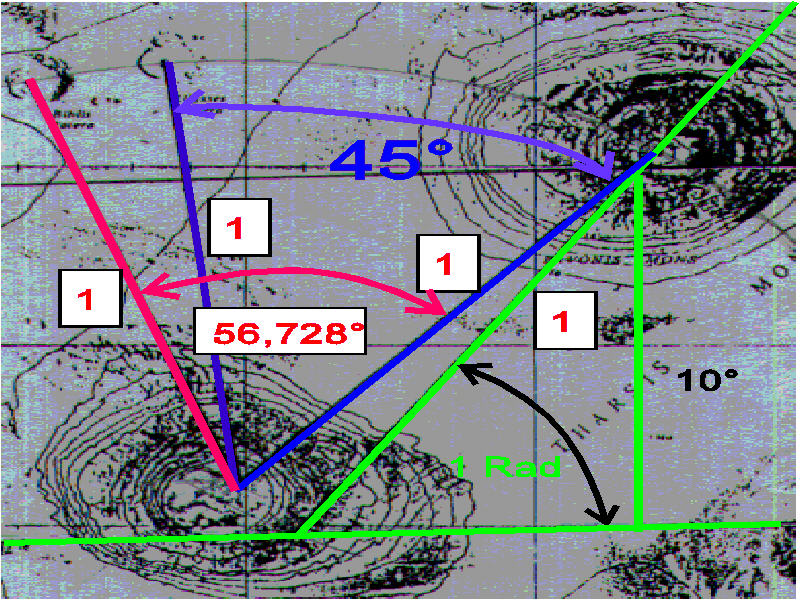 |
Let
use the Tang-Lang language:
Tang(45°)=1
and this is the Sun-earth middle distance. Blue angle.
Tang(56.729)=1.524
This
is the sun-earth middle distance. Red angle.
It
should correspond to the value of the angle whose tangent gives 1.524 for
here it is right next to the Mars crater. At last the 1 and the 1.524 can
be found in a different form, nicely divided, to show that the addition
of the number was deliberate, and this serves to lessen our doubts.
The
two small craters are at equal distances from the big Mars crater. That
is to say, the two small craters are connected by their data.
But
let us look at the area around Venus, too. We can find near left hand a
small crate named Ng objekt by NASA.
We find the astronomical datas again, exactly where it ought to be, given in exactly the angle we would have expected. It should be noted that this small crater is at a distance that divides the Venus-Earth distance in two, giving a ratio of the Sun-Earth and the Sun-Mars distances e Sun-Mars distances (1 ans 1.524), and so, this is the foth method of conveying the data of Earth and of Mars.
But let us take a look at the distances.
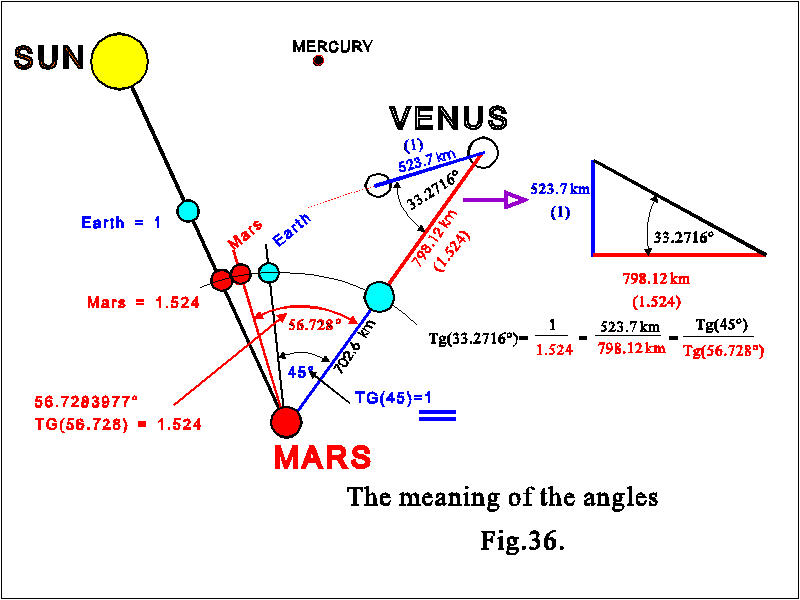
The
distance between the Venus and Earth volcanoes is 798.12 km. ( upper volcanoe).
If this represents the Sun-Mars distance - 1.524 -, then the distance of
the Venus-Ng objective should be 798.12/1.524 = 523.7, which it is. Now
523.7 is one unit (Sun-Earth) and 1.524 times this (798.12 km) is equivalent
to the Sun-Mars unit. If we measure the angle between the two distances
we find that it is approximately 33.27 degrees. We are given the value
exactly if we divide 523.7 km by 798.12 km or 1:1.524 = 0.6561679.
This then, would be the tangent of the angle. Let us calculate the angle
from this. Arctangent(0.6561679) = 33.27160(...). Such a presentation of
the side lengths and the angles calls us to position the sides in a right-angle
and in this interpretation we see the circular function of the tangent
about which we learnt at school.
|
Return to menu
foldesa@digikabel.hu |
All rigths by Attila Foldes